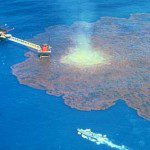It’s Day 100 of the BP oil disaster in the Gulf, and if you just read the New York Times and Washington Post headlines this morning, you might be feeling pretty hopeful that soon enough, you won’t have to think about oil spills for a while.
 Not so fast. On Tuesday, another spill was detected in the Gulf, the result of a boat colliding with an out-of-use wellhead in Barataria Bay. NBC reported that it was small in size, but near a marshy and ecologically sensitive area of Louisiana.
Not so fast. On Tuesday, another spill was detected in the Gulf, the result of a boat colliding with an out-of-use wellhead in Barataria Bay. NBC reported that it was small in size, but near a marshy and ecologically sensitive area of Louisiana.
Officials said on Tuesday that the spill would likely be contained within the day, but when I called the Coast Guard this afternoon, I was told the well was still spewing oil and gas.
Well control did arrive on the scene and are in the process of shutting that well right now, Coast Guard Petty Officer Tom Atkeson told me. I do not have an exact figure on the amount of gallons that have been spilled. It looks like most of it is natural gas.
The protective measures that we’re now all-too-familiar with have also been put in place for this spill safety zones around the site, and nearly 11,000 feet of boom.
Up in Michigan, The Detroit News reports that workers are still fighting what could rank as the Midwest’s worst oil spill. More than 800,000 gallons of oil spilled from a ruptured underground pipe and entered the Kalamazoo River. Residents had detected the smell of crude on Sunday evening, but no one knows how long the leak was happening, and there are still questions of whether the flow from the pipeline has been completely shut off.
Canada’s Enbridge pipeline company has pledged to clean up the spill, but told reporters it will take months.
Benzene, a carcinogenic constituent of crude oil also detected in the Gulf, has been detected in the air. The EPA said data haven’t shown levels that are immediately dangerous to human health and life, but added, “That’s not to say we are confident that those levels are acceptable for long-term exposure.”
As many as 30 families have been relocated, and the cause is being investigated, according to the News.
Michigan’s governor, Jennifer Granholm, has called the response to the spill anemic. (And yes, there are photos, if you haven’t had your fill of oil-covered birds.)
This particular pipeline typically carries about 8 million gallons of oil per day, from Indiana to Ontario, The Associated Press reported. With plans already in the works for another pipeline that would stretch from Canada to the Gulf, perhaps the EPA was wise, given our recent troubles, to slow down the approval process for this project just a tad.
by Marian Wang
ProPublica


